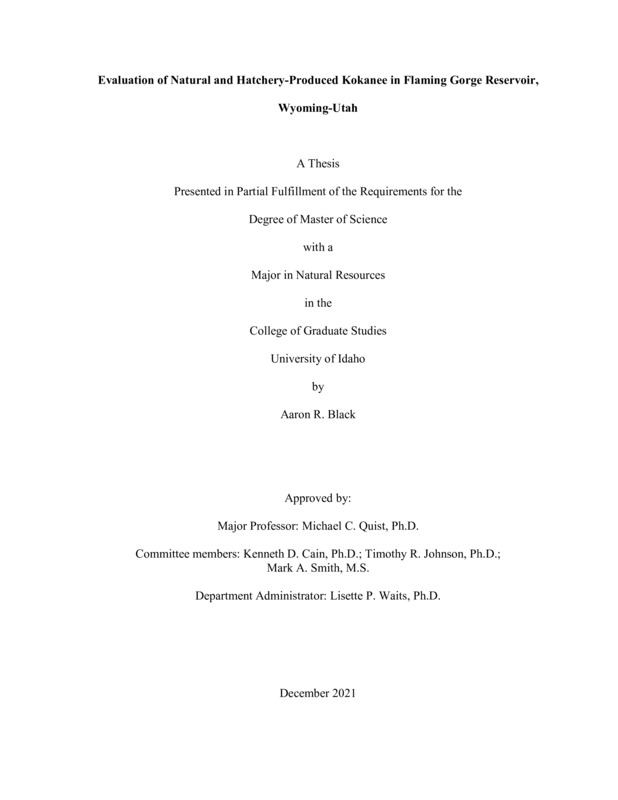Evaluation of Natural and Hatchery-Produced Kokanee in Flaming Gorge Reservoir, Wyoming-Utah
Black, Aaron R.. (2021-12). Evaluation of Natural and Hatchery-Produced Kokanee in Flaming Gorge Reservoir, Wyoming-Utah. Theses and Dissertations Collection, University of Idaho Library Digital Collections. https://www.lib.uidaho.edu/digital/etd/items/black_idaho_0089n_12236.html
- Title:
- Evaluation of Natural and Hatchery-Produced Kokanee in Flaming Gorge Reservoir, Wyoming-Utah
- Author:
- Black, Aaron R.
- Date:
- 2021-12
- Keywords:
- Flaming Gorge Reservoir Kokanee Otolith Microchemistry Strontium
- Program:
- Environmental Science
- Subject Category:
- Aquatic sciences
- Abstract:
-
Kokanee Oncorhynchus nerka were first stocked in Flaming Gorge Reservoir (FGR), Wyoming-Utah, in 1963. In a system that uses supplemental stocking to enhance a popular sport fishery, an understanding of the contributions from natural and hatchery-produced fish is critically important so that hatchery resources can be appropriately allocated. The goal of this research was to identify the natal origin (i.e., natural, hatchery) of kokanee in FGR using otolith microchemistry. Return to the creel, composition of spawning aggregates, and growth of kokanee in Flaming Gorge Reservoir were evaluated with a focus on differences associated with natal origin. Kokanee otoliths collected from hatcheries (n = 60) and FGR (n = 1,003) were analyzed for the strontium isotope ratio, 87Sr/86Sr, using laser ablation and a multi-collector inductively coupled plasma mass spectrometer. Kruskal-Wallis tests were conducted to compare the Sr isotope ratios from the otolith edge of kokanee sampled from hatcheries and FGR. Strontium isotope ratios differed for eleven out of twelve hatcheries (P< 0.01). The Wigwam Hatchery was not significantly different from FGR (P = 0.84). Model-based discriminant function analysis was used to assign a natal origin for kokanee caught in FGR. Hatchery contribution to the population at large varied from 21% to 50% among year classes. The percentage of hatchery kokanee in the creel (18-50%) was similar to what was observed in the population. Hatchery-produced kokanee contributed a higher proportion to tributary-spawning aggregates (40-90%) than shoreline-spawning aggregates (19-58%) by sample year. Growth of natural and hatchery kokanee was similar, suggesting similar performance in the system. Results from this study identify that hatchery supplementation contributes to the population and recreational harvest of kokanee in FGR. This research also provides insight on the ecology of kokanee that is useful for better understanding kokanee population dynamics in reservoir systems.
- Description:
- masters, M.S., Environmental Science -- University of Idaho - College of Graduate Studies, 2021-12
- Major Professor:
- Quist, Michael C.
- Committee:
- Smith, Mark A.; Cain, Kenneth D.; Johnson, Timothy R.; Waits, Lisette P.
- Defense Date:
- 2021-12
- Identifier:
- Black_idaho_0089N_12236
- Type:
- Text
- Format Original:
- Format:
- application/pdf
- Rights:
- In Copyright - Educational Use Permitted. For more information, please contact University of Idaho Library Special Collections and Archives Department at libspec@uidaho.edu.
- Standardized Rights:
- http://rightsstatements.org/vocab/InC-EDU/1.0/

